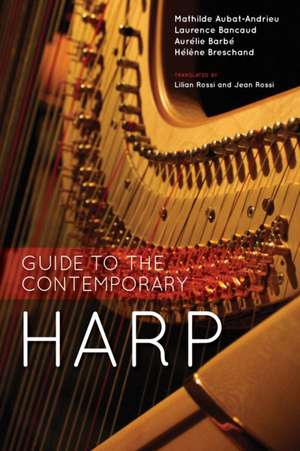Guide to the Contemporary Harp
Autor Mathilde Aubat–andrieu, Laurence Bancaud, Aurélie Barbé, Hélène Breschand, Félicité De Lalandeen Limba Engleză Paperback – 10 feb 2019
| Toate formatele și edițiile | Preț | Express |
|---|---|---|
| Paperback (1) | 234.06 lei 6-8 săpt. | |
| MH – Indiana University Press – 10 feb 2019 | 234.06 lei 6-8 săpt. | |
| Hardback (1) | 445.29 lei 6-8 săpt. | |
| MH – Indiana University Press – 10 feb 2019 | 445.29 lei 6-8 săpt. |
Preț: 234.06 lei
Nou
44.79€ • 46.21$ • 37.38£
Carte tipărită la comandă
Livrare economică 27 martie-10 aprilie
Specificații
ISBN-10: 025303938X
Pagini: 216
Dimensiuni: 207 x 312 x 15 mm
Greutate: 0.3 kg
Editura: MH – Indiana University Press
Cuprins
Acknowledgements
Introduction
1. Organology
I. Historical Reminders
II. The Pedal Harp
General Characteristics
The Parts of the Harp
The Strings
The Pedals and the Modulation Mechanism
"Using the Pedals"
Pedal Notation
Playing the Harp
III. The Lever Harp
General Characteristics
The Strings
Levers and the Modulation Mechanism
Playing the Lever Harp
IV. Electric Harps
The Electroacoustic Harp
The Electric Harp
The Electric-Acoustic Harp
V. Some 21st Century Creations
The MIDI Harp
The Automatic Harp
2. Writing and Language
I. Notations
Measured Notation
Unmeasured Notation
Proportional Notation
Introduction of the Aleatory Element (Indeterminacy)
Open Works
Combination of Several Notations
Superposition of Different Tempi
Writing on Several Staves
Writing with Another System than the Five-Line Stave
Graphic Scores
II. Dramatized Writings
Micro-Choreography, Theatrical Gestures
Dramaturgic Use of the Voice
Use of the Sung Voice, with No Theatrical Indication
Use of the Spoken and/or the Sung Voice with No Text
III. Mixed Forms of Music
Some Works for Harp and Extensions
3. Playing Techniques
I. Timbre
"Près de la table" (Near the Soundboard)
"Bas dans les cordes" (Low in the Strings)
"Près des chevilles" (Near the Tuning Pins)
Harmonic Sound
Sound Using the Fingernail
Koto Sound
Plucked Sound
Vibrated Sound
Portando From One Pitch to Another
Xylo Sound
Pizzicato (Pizz.)
Bartók Pizzicato
Normal Position
Bisbigliando
Tone-Color Melody (Klangfarbenmelodie)
II. Glissandi, Chords and Clusters
Single Glissando
Fast Glissando
Multiple Glissando
Pitchless Glissandi
Flat, Broken, Arpeggiated/Rolled Chords
Cluster Glissando
Rasgueado
Cluster Glissando with Thunder Effect
Cluster
Muffled Cluster
Tremolo Cluster
Aeolian Cluster
Various Forms of Rubbing
III. Resonances, muffles and silences
Muffles
Let Vibrate
Fermata
IV. Hits on the harp
Different Types of Hits
Which Part of the Harp to Hit?
Composers Who Have Elaborated a Detailed Notation for Hits
V. Wire strings
Whistling Sound (with the Palm of the Hand)
Wired Sound (Grabbing a Wire String with the fingers)
Scrape with a Nail or a Plectrum
Buzz
Thunder Effect
Sustained Thunder Effect
VI. Pedals and Levers
Pedal Glissando
Pedal Trill
Rhythmic Effect with Pedals
Pedal Movement Ad Libitum with Sound Effect
Pedal Buzz
Resonant Pedal Sound
Levers
Thunder Effect
VII. Using Objects
Metal Rod
Stick
Use of Percussion Instruments by the Harpist
Bow
Electronic Bow
Plectrum
Other Objects
Prepared Harp
Inserting Materials Between the Strings (Foam, Paper, Cardboard, Textile, Rubber, Elastic Band, etc.)
VIII. Scordatura
Pedal Harp
Lever Harp
Two Harps
Conclusion
Significant Landmarks
List of Notations
Bibliography
The History of Music in the 20th and 21st Centuries
Contemporary Notation
Musical Instruments, The Orchestra
The Harp
Internet Sites
Repertoire of Works for Harp
Solo Harp
Harp and Extensions
Lever Harp
Lever Harp and Extensions
Duets and Harp Ensembles
Concertos
Duets
Trios
Quartets and More
Ensembles and Extensions
Index of Composers Quoted
Index of Playing Techniques
Notă biografică
Mathilde Aubat-Andrieu is a harpist and cofounder of the association Les Signes de l'arc (The Signs of the Arch). She was awarded a gold medal and first prize in proficiency at the Music Conservatory in Troyes (France) and gives regular performances at reading-concerts, with chamber music ensembles and orchestra.
Laurence Bancaud is a harpist and cofounder of the association Les Signes de l'arc. She was awarded first prize at the CNSMD (Conservatoire National Supérieur de Musique et de Danse) and has a master's degree in musicology and specializes in contemporary music. She is author of Tôn-Thât Tiêt: Dialogue Avec la Nature.
Aurélie Barbé is a harpist, composer, and cofounder of the association Les Signes de l'arc. She was awarded a gold medal at the Music Conservatory in Caen (France) and a higher studies diploma in musicology. She is a teacher and performer, specializing in modal, minimalist and improvised music for both classical and electric harp.
Hélène Breschand is a harpist, composer, and cofounder of the association Les Signes de l'arc. She was awarded a gold medal and first prize in proficiency at the Conservatoire à Rayonnement Regional in Paris. She pursues her career as a soloist in the contemporary repertoire and in new creations, improvisation, and musical theatre.
Lilian Rossi has pursued an academic career and is the author of Doctors and Nurses. Jean Rossi is an administrative officer. Working as a team, they have translated numerous academic and literary works from French and German.
